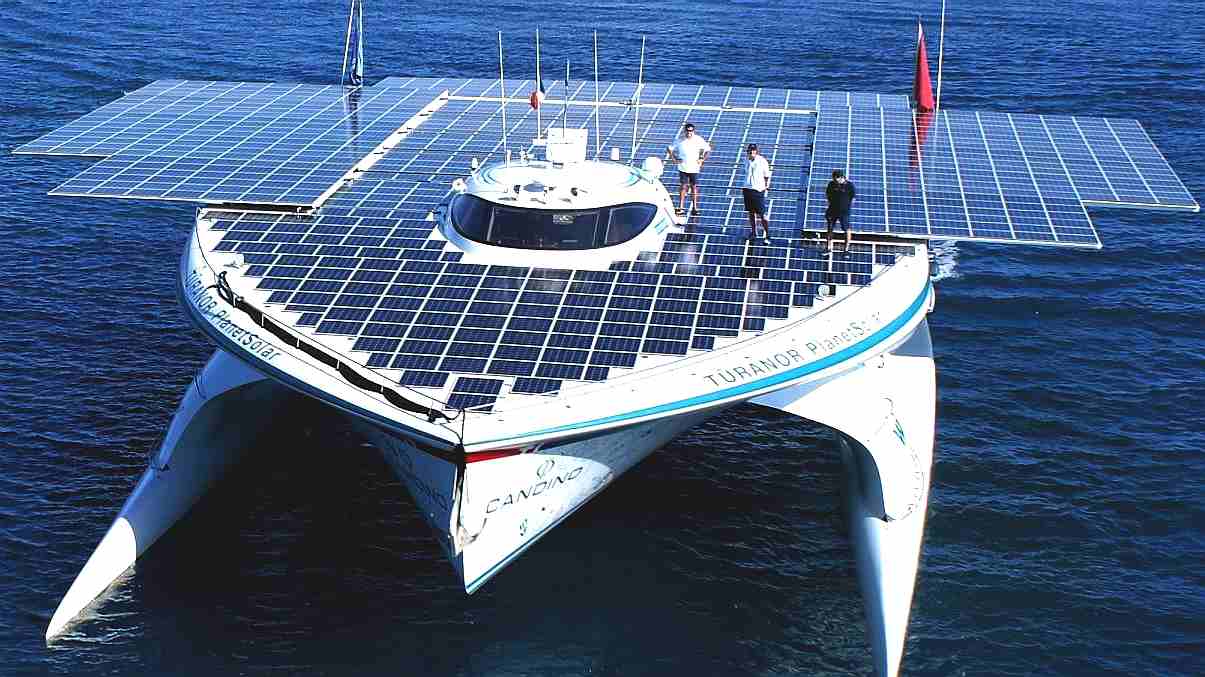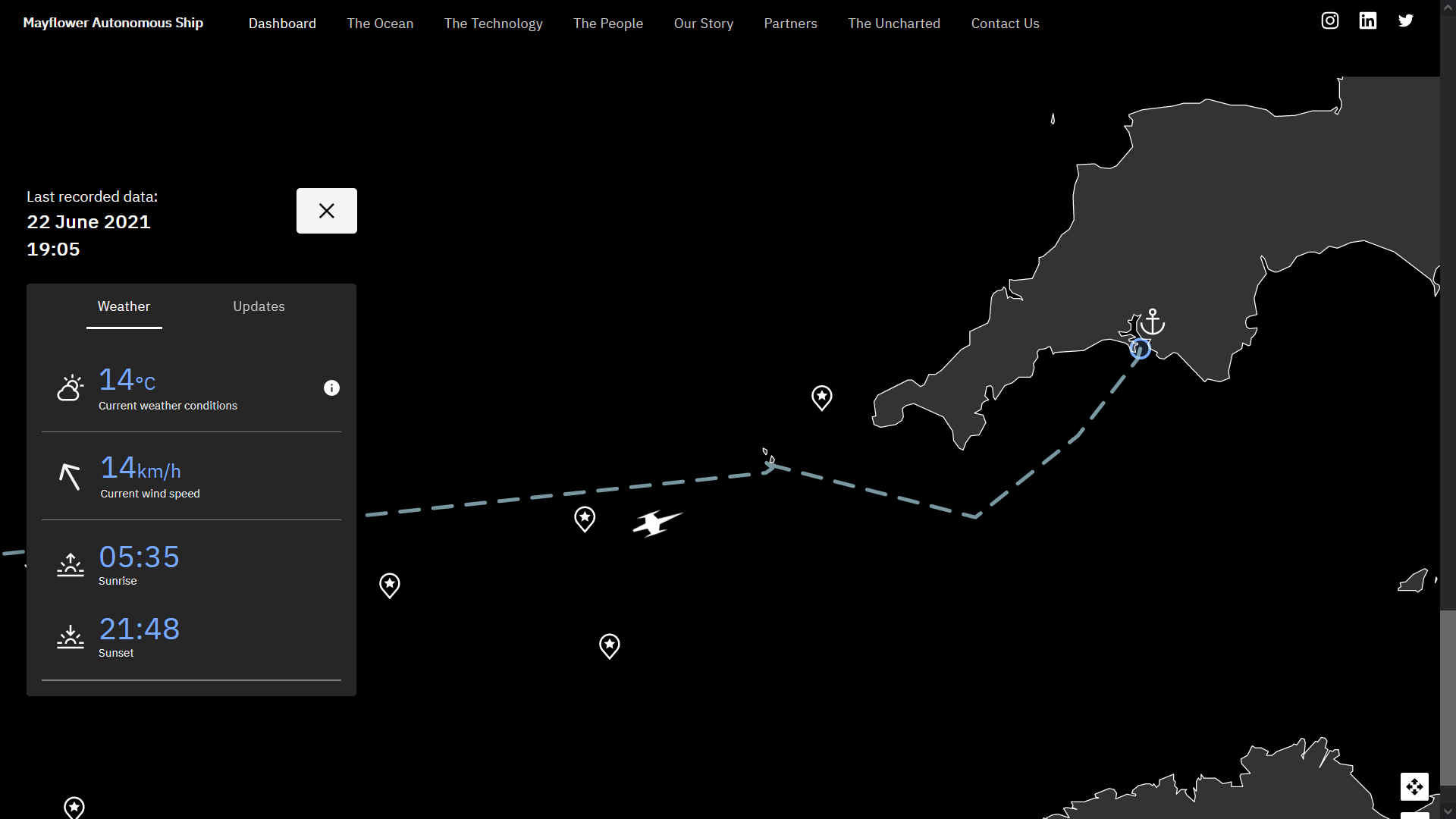
8th
DAY 23rd JUNE 2021
- The last recorded data is shown as 22nd June 2021. The difference
being that the trimaran appears to be heading back to Plymouth. If that
is so, we hope the Mayflower is safe and may soon (don't rush things) be
able to embark on a new mission. The Washington
Post shed some light on the plight of the Mayflower on Friday 18th
June.
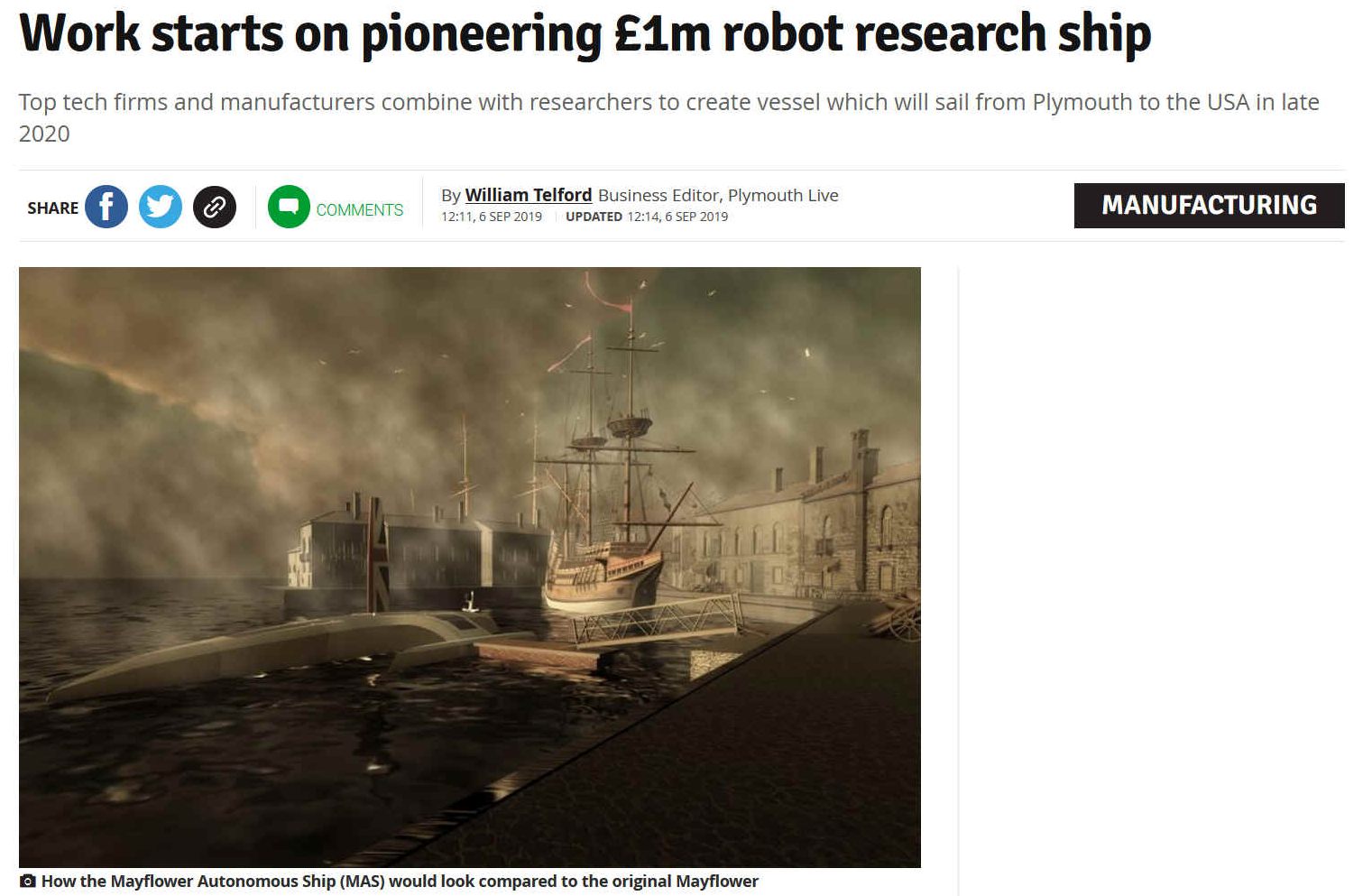
MILITARY
DEAL
- MSubs has just (Sept 2020) signed a £2
million pound deal to create a robot sub for the Royal Navy and has produced unmanned submersibles for the US
military, we presume, using similar technology. Warmongering apart, the
good news is that the technology is suitable for civilian ships of the
future, in the fight against global
warming.
The world's gaze was on Plymouth as leaders come together for the landmark launch of the Mayflower 2 Autonomous Ship from the Barbican for Mayflower 400.
US Ambassador Robert Wood Johnson
was in Britain's Ocean City marking the incredible historic departure
(actually launch) of the Mayflower for the New World.
Woody Johnson was in town to launch the new vessel, the Mayflower 2 – one of the first full-sized fully autonomous ships to be capable of crossing the Atlantic using
a diesel engine, wind and solar power.
The Ambassador hailed the project in a special article written for the Western Morning News as an example of Britain and America working together to push the boundaries of science and build trading links.
According
to many website(s), the Mayflower is £1
million pound
vessel powered by AI and energy from the
sun, but also (rather confusingly) has a diesel
engine onboard and a sizable fuel tank, but very few solar panels,
although increased in number since launch in September 2020. Hence, it
was thought that it was the onboard marine sensors and navigation equipment
that is solar powered, rather than being energy autonomous in propulsion
terms. Then in July of 2021, the vessel set off to cross the Atlantic,
sporting nearly double the solar panels when christened.
This may be different from the (100 foot) specification from the
original Crowdfunder, but then they had set themselves a serious
challenge in a short time, and Covid 19 would not have helped. Reading
between the lines, we think this is where the media coverage on launch
might be seen as confusing. If we are not correct on this, then
obviously we will clarify as Promare and IBM may care to suggest -
otherwise we'll assume our assumptions are correct.
Any
earlier disparity in description should not detract from the admirable
objectives and significant progress that the project represents.
Another
solar ship that has backup generator, is the Energy
Observer, that converts sunlight to hydrogen, stores it in high
pressure tanks, and calls on the gas when electricity is needed, using
fuel cells.
This Autonomous Ship, a
trimaran similar to the Nigel
Irens, Cable
and Wireless Adventurer (diesel powered) in design - only smaller, will be able to spend long durations at sea collecting critical data about the
ocean thanks to solar panels - and possibly - a small wing sail - that
is shown in the media releases, but not
yet fitted. But in fact will more than likely not be fitted. A shame
maybe, but time is working against them!
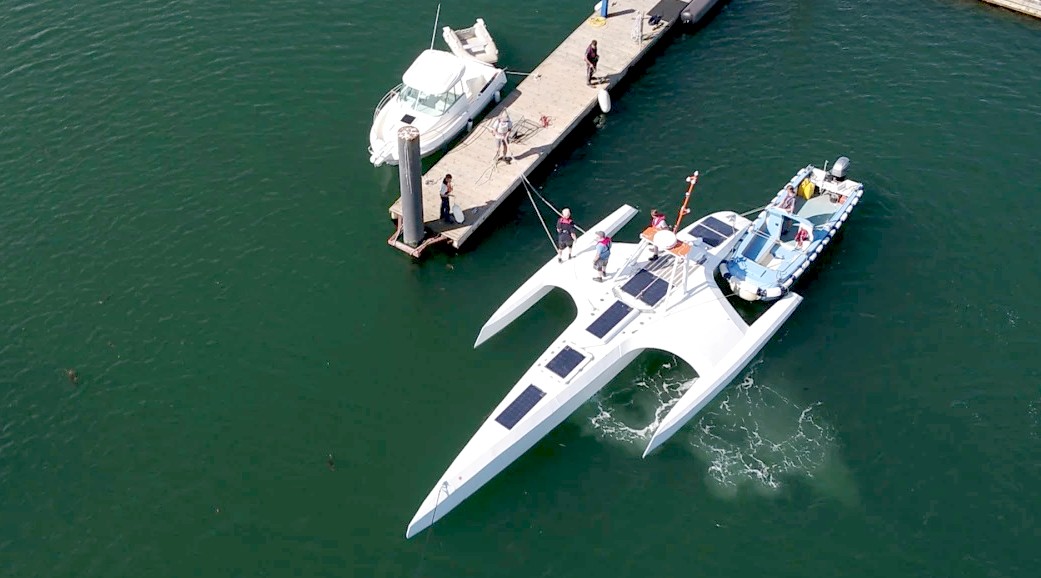
KEY POINTS
- 1. The solar-powered research boat will aim to traverse the Atlantic Ocean
in 2021 with no humans on board. 2. Sea trials are due to commence off the south coast of England in
late 2020. 3. The Mayflower was officially unveiled on September 16th
2020, the 400th anniversary of the original Mayflower departure. In our
view this is a very important project in terms of unmanned, autonomous,
navigation.
Crucially,
at 15 meters in length,
Mayflower is much larger than the Scout from 2013 and
Solar
Voyager, a kayak
from 2015/16, hence, armed with a veritable army of AI sensors, the boat
stands
an excellent chance of succeeding in its mission across the Atlantic. The Scout managed about half way across the Atlantic, before the team lost
comms - and they had rudder problems. Scout was coming from the US to
the UK. The Voyager managed about a quarter of the planned voyage. But
these were very low budget projects, not armed with artificial
intelligence from high powered computers.
Finally,
in 2018, the Sailbuoy
Met, a 2 meter sail powered boat, made it across the Atlantic to
claim the first successful autonomous crossing. But then small boats are
not compelled to comply with COLREGS, and sure enough it does not. But
then again, neither does the Mayflower - according to their published
specification. They are though looking to negotiate amendments to the
1972 rules as being outdated.
The
Mayflower Autonomous Ship (MAS) is in our view a superb project that
could advance the state of the art - in going a long way to advance the
case for autonomous vehicles, and perhaps some slight amendment to
COLREGS, such that others might enjoin and enjoy the
'AI
Captain' technology for marine navigation purposes.
An autonomous
(unmanned) circumnavigation of the globe was first proposed in 2012/13 by Bluebird
Marine Systems Ltd, with their 'Bluefish' project. The first port of
call was to make sure the IMO were not about to revise the COLREGS, and
this they confirmed in writing.
A
slightly more developed form of IBM's AI
Captain may make such a proposal a reality for other teams with similar
ambition, such as the Cleaner
Ocean Foundation, where they took up the torch when Bluebird Marine
ceased trading in 2017. For example, the Elizabeth
Swann is designed to comply with COLREGS
as they are currently.
TRANSATLANTIC
EVENT CALENDAR 2021
CROWDFUNDING
On 19th December 2016
the "Team," with support from Bowater Communications, successfully raised £102,940
of crowd
funding with 142 supporters in 56 days,
via Crowdfunder.
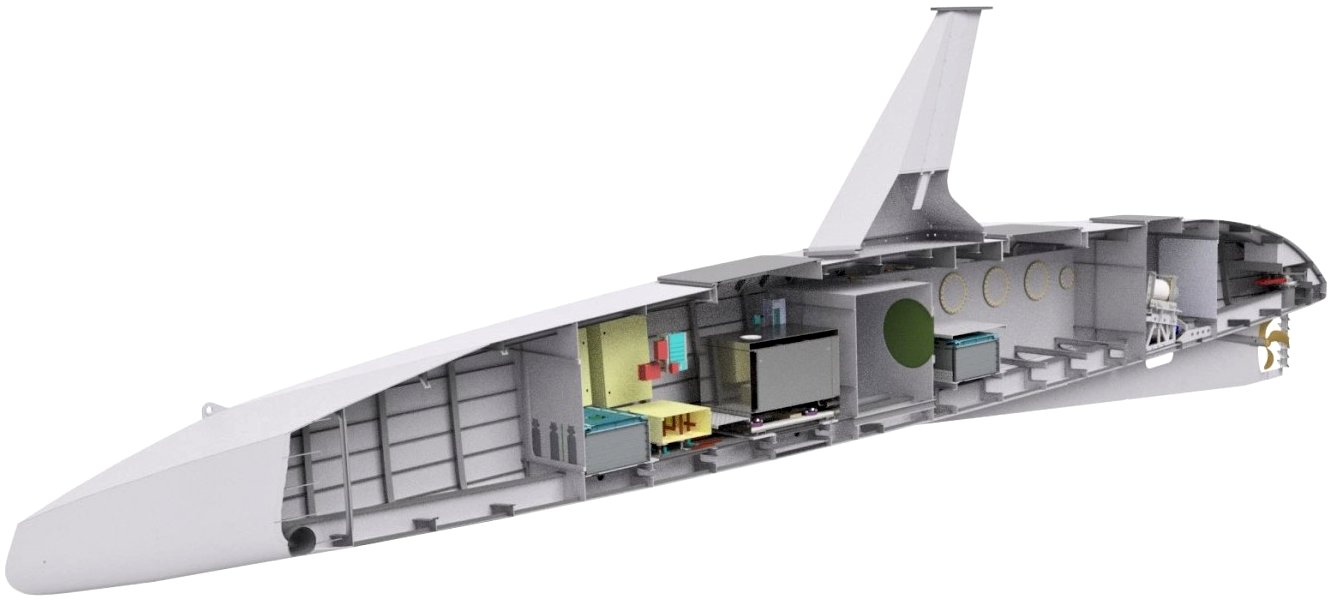
We
like the naming of the 'Mayflower' project, though somewhat tenuous in
that this is a crew and passenger less boat (not really a ship because
of its boat size), but at least it involved Plymouth as the launch platform
and an authentic destination in the US - though the expedition did not
take place on the 400th anniversary. Again due to Covid19, and a real shame. But
they did their best, and pulled out all the stops to at least achieve a
launch on time. So, well done on that.
Working in tandem with human oceanographers and other autonomous vessels, the new-generation Mayflower provides a flexible and cost-effective option for deepening understanding of critical issues such as
global
warming, ocean plastic pollution and marine mammal
conservation, such as whales.
The Mayflower Autonomous Ship is led by marine research organisation
Promare, supported by IBM and a global consortium of partners.
See below for more details.

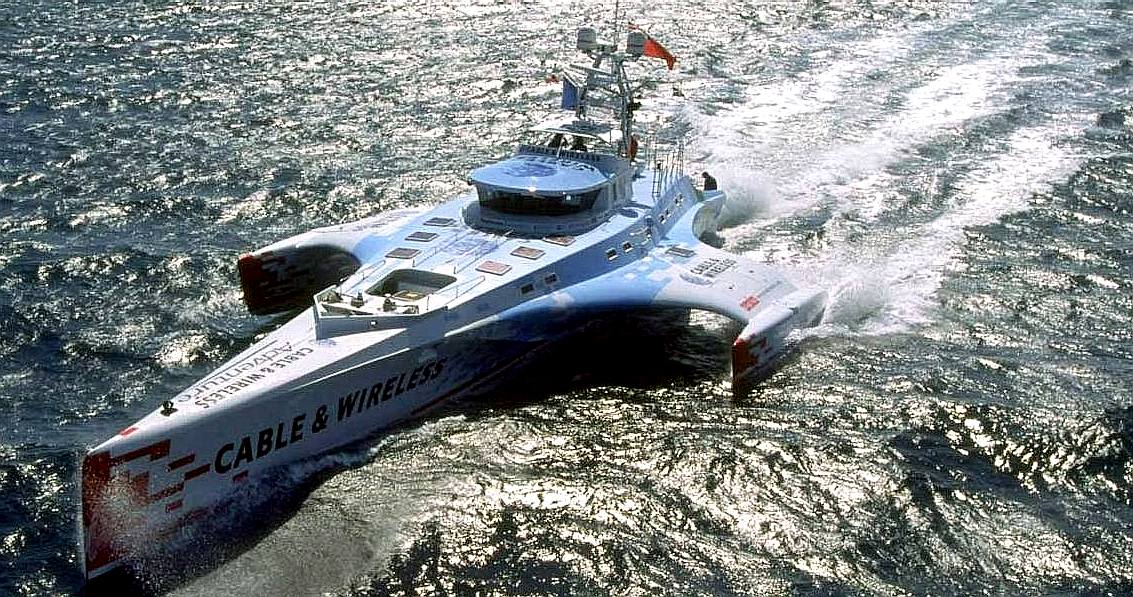
AUTONOMOUS
CONCEPT: It seems from the specifications that unlike the Cable
& Wireless Adventurer, the Mayflower is not designed to break
any speed records - despite its racy looks - but is more a floating IT
station, bristling with a veritable army of computers and sensors. The
hull is solid state, inasmuch as there are no moving parts to aid the
harvesting of energy from nature.
CNBC
NEWS SEPT 11 2020, LONDON
Humans aren’t the only ones to have had their travel plans ruined by the coronavirus. A robot-powered boat that was due to cross the Atlantic this month has been forced to delay its voyage until next April after the virus caused complications in its development.
The autonomous 15-meter trimaran has been built to push the boundaries of autonomous shipping while gathering scientific data on the ocean. The Mayflower Autonomous Research Ship (MAS for short) is being led by marine research organization
ProMare, while
IBM is the main technology partner.
The solar-powered vessel is set to start trials off the south coast of England in the coming weeks and it will be officially unveiled on Sep. 16, the 400th anniversary of the Mayflower departure in 1620. After that, it will go on several voyages and missions over the next six months ahead of a transatlantic voyage in April 2021.
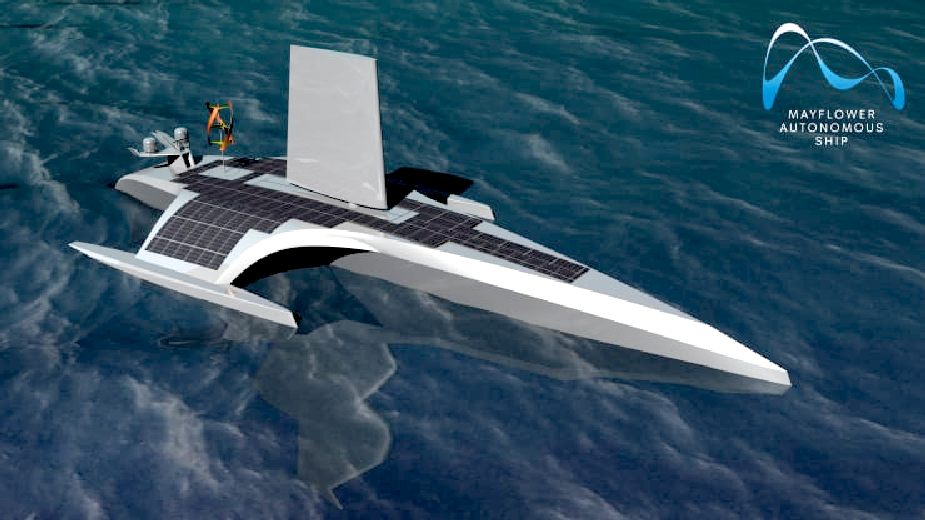
SOLAR
POWER: What is shown here is not the real deployment of solar panels
aboard the final launched version of the Mayflower. It seems from what
was included at the launch, that approximately 1,800 watts of power
during daylight hours @ 10 hour average (optimistic) = 18kW/hrs of
energy divided by 24 hours = .75 kW (or 1 horsepower) for propulsion.
Minus whatever power consumption is needed for the AI Captain. Meaning
that the Mayflower would be unlikely to travel at speeds higher than a
couple of knots in the open ocean on solar power alone - and that is an optimistic
appraisal. Hence, the vessel must be mainly powered by the diesel
generator. She is not solar powered. She is solar assisted.
During that transatlantic crossing, the ultramodern ship will broadly retrace the Mayflower’s original route from Plymouth to Cape Cod’s Provincetown.
Andy Stanford-Clark, chief technology officer for IBM U.K. and Ireland, who’s leading the science on the ship, told CNBC that the vessel relies on an onboard AI Captain which uses computer vision, automation software and Watson technology — IBM’s most notable AI platform.
The ship’s operators tell the Mayflower where they want it to go and then it will figure out how to get there itself, considering the weather, ocean currents, collision regulations and other variables. The Mayflower can also react to ocean traffic in real time using a combination of radar, cameras, and the Automated Identification System (AIS), which transmits information such as the Mayflower’s latitude and longitude to other boats.
While AI does not control every aspect of the Mayflower, it does play a significant role in the ship’s operations.
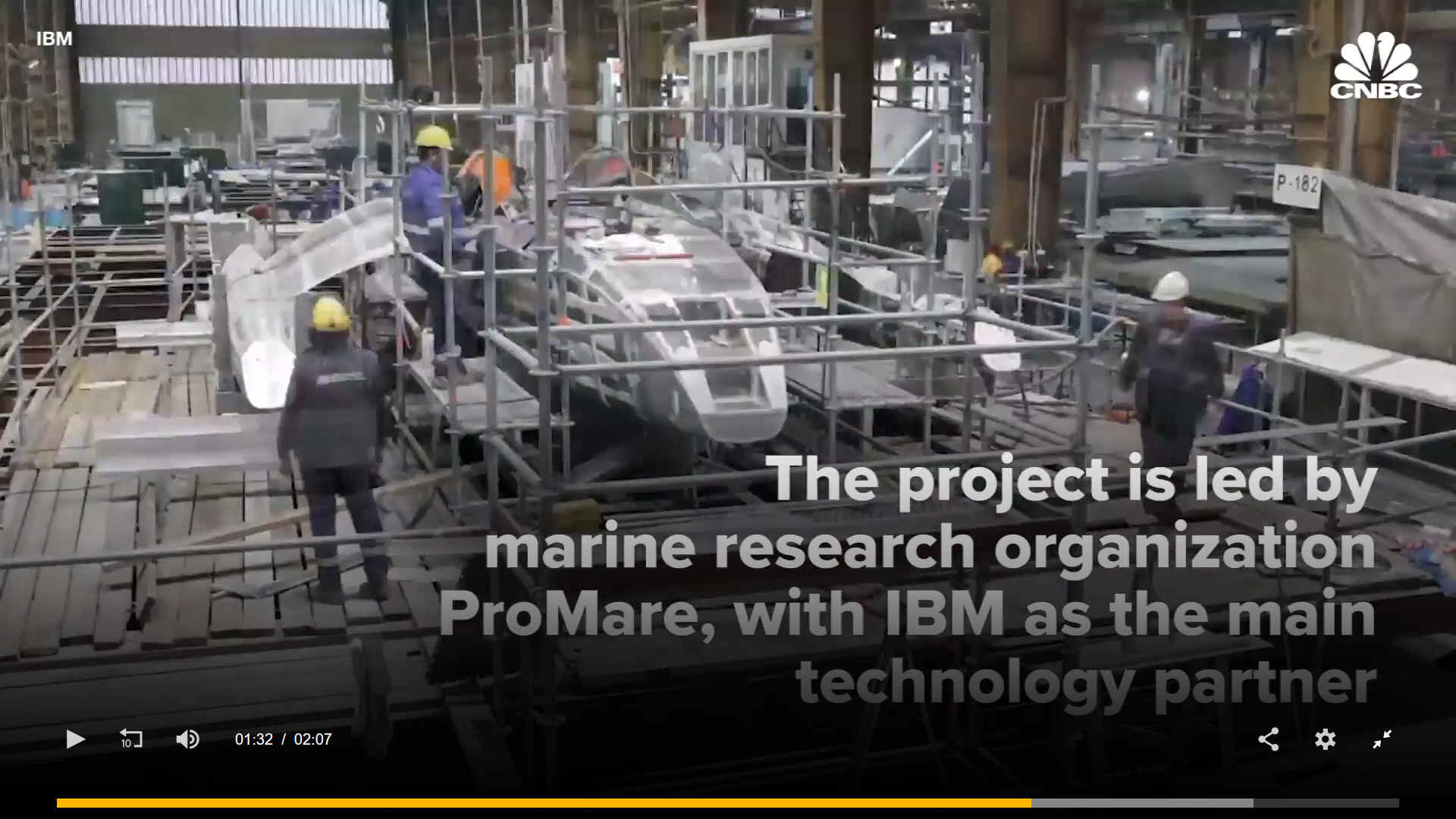
ONBOARD
EXPERIMENTS
Inside the boat, instead of there being crew, living quarters, a bathroom, a galley, beds and so on, there are science experiments.
Various organizations have pitched experiments that they’d like the Mayflower to carry out while at sea.
One of them is a water analysis experiment that samples the seawater every few hours and stores it in roughly 100 bottles that are capped and kept in a crate onboard ready for human inspection back on land. “Because we’ll know exactly where in the ocean we took the sample, we can say at this point, the salinity was this, the algal bloom quantity was this, the pH was this, and the
oxygen levels were this,” said Stanford-Clark.
Scientists at the U.K.’s Plymouth University will analyze the same samples to determine microplastic levels at various points in the ocean.
IBM claims it has also developed a system that can identify whales and the pod they’re from based on their song, which is picked up by an onboard hydrophone. “We’re training an AI to listen for whale songs,” said Stanford-Clark. The same hydrophone is used to listen out for faults on the Mayflower.
There’s another project that will involve analyzing the shape of the Earth. “We’re going to use very accurate GPS to measure exactly the level of the ocean, and then subtract the tides and the weather and the wind and use that to get a unified model,” said Stanford-Clark.
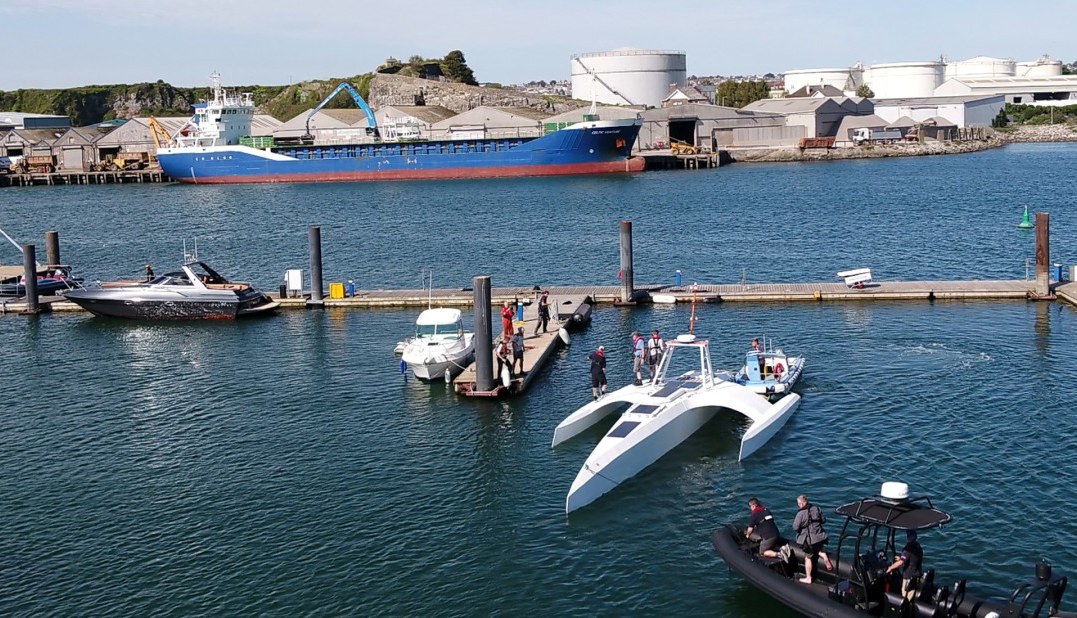
FLEETMON
14-9-2020
- Ever since tech giant IBM joined hands with ProMare and the Finnish Wärtsilä to develop one of the world’s full autonomous ships, the internet has been abuzz with their activities.
The Mayflower Autonomous Ship (MAS) is one of the most high-profile initiatives striving to revolutionise a 10,000-year-old transportation format. Any breakthrough in this project has the possibility to massively transform the way commercial shipping operates.
Drones have replaced traditional jets in the sky. Tesla's autonomous cars are disrupting the automobile industry. So now, the question arises: Why don't we see the same on our waters?
COVID-19
DISRUPTIONS ON MANNED RESEARCH VESSELS
The new Mayflower could signify a change in the way ocean research is carried out in the future.
Coronavirus disruptions on manned research vessels are leading to a reduction in data about the weather and
climate
change, according to UNESCO’s
Intergovernmental Oceanographic
Commission.
Reduced air travel means there’s a dearth of weather data from the skies as well.
All these disruptions could result in less accurate weather forecasts and climate models, the Commission has said.

20 SETTEMBRE 2020 - Mayflower Autonomous Ship: al timone c'è l'IA
Quattrocento anni fa partiva l’avventura della Mayflower, la nave che portò i padri pellegrini sul continente americano ove di fatto nacquero gli Stati Uniti d’America. Alla simbolica distanza di 400 anni esatti, dallo stesso porto di Plymouth, è partita la prima nave a guida autonoma: la Mayflower Autonomous Ship (MAS).
Mayflower Autonomous Ship
Il progetto nasce dalla collaborazione tra IBM e ProMare dopo un lavoro lungo due anni. La Mayflower Autonomous Ship è un trimarano che nasce come strumento di studio a disposizione dell’oceanografia, per studiare i cambiamenti climatici, l’inquinamento delle acque e la salubrità della fauna marina.
L’imbarcazione è arricchita da oltre 30 sensori e 6 videocamere, quanto basta per sostituire completamente la presenza umana a bordo. Lunghezza di 15 metri, larghezza di 6,2 metri, 5 tonnellate di peso complessivo e motore ibrido con alimentazione solare. La guida è completamente affidata all’hardware di bordo ed alla capacità di scrutare l’orizzonte in cerca di possibili pericoli. Le informazioni meteo, l’analisi dello stato di navigazione e le istruzioni ricevute saranno gli input che la Mayflower Autonomous Ship potrà analizzare per stabilire rotta e ritmo di viaggio.
Questo primo prototipo ha scopi scientifici dichiarati, ma offrirà a IBM moltissime informazioni utili a comprendere quando e se si potrà realmente approdare ad una guida autonoma sui mari anche per il trasporto di merci o persone. La prospettiva è chiaramente interessante, perché si potrebbero ridurre costi e rischi migliorando l’efficienza di un settore che sotto molti punti di vista ha ancora ampi margini di innovazione davanti a sé.
La prossima sfida sarà lanciata nella primavera del 2021: attraversare l’oceano, per arrivare laddove l’uomo approdò 400 anni or sono per costruire il proprio futuro. Il nome Mayflower, prima ancora di essere un ricordo, è un’ambizione.
By giacomo
dotta
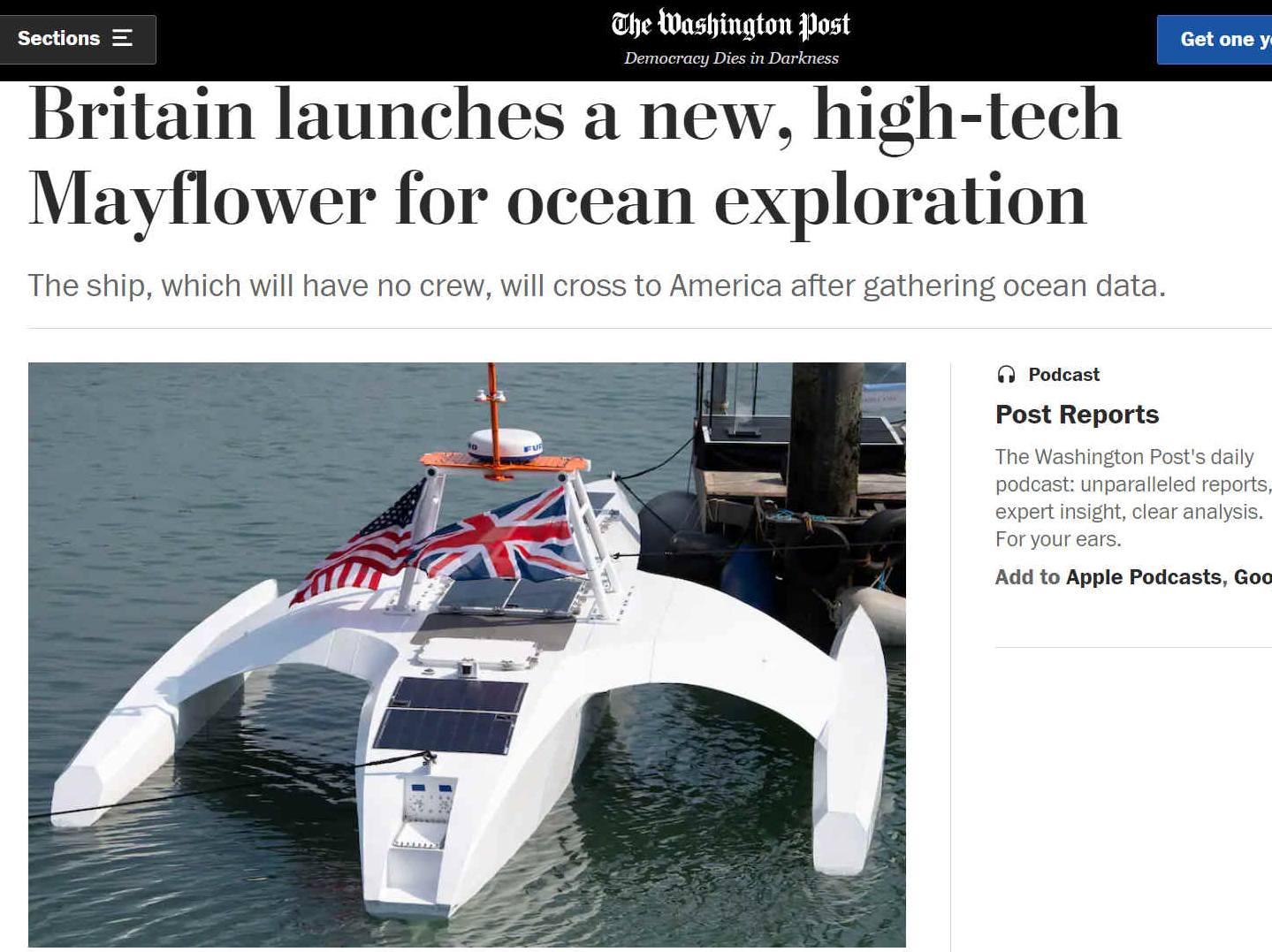
THE
WASHINGTON POST 17 SEPTEMBER 2020
Britain launches a new, high-tech Mayflower for ocean exploration. The ship, which will have no crew, will cross to America after gathering ocean data.
The U.S. ambassador to Britain officially launched a ship named Mayflower on Wednesday, 400 years to the day after a
wooden vessel with that name sailed from an English port and changed the history of two continents.
Unlike the merchant ship that carried a group of European Puritan settlers to a new life across the Atlantic Ocean in 1620, the Mayflower christened by U.S. Ambassador Robert Wood Johnson has no crew or passengers. It will cross the sea powered by sun and wind, and steered by artificial intelligence (AI).
Johnson said the high-tech ship, developed jointly by British-based marine research organization ProMare and U.S. tech giant IBM, showed that “the pioneering spirit of the Mayflower really lives on” in the trans-Atlantic partnership.
“We’re heading out with the same spirit of adventure and determination and vision for the future” as the original colonists, the American diplomat said.
Like the Mayflower in 1620, the new vessel will travel from Plymouth, England, to Plymouth, Massachusetts, but on a marine research trip rather than a colony-founding journey. The coronavirus pandemic has delayed its trip until the spring of 2021.
The ship’s launch in Plymouth, 200 miles southwest of London, is part of Mayflower commemorations disrupted by the coronavirus pandemic. They involve British, Americans and Dutch institutions — many of the 17th-century Pilgrims had fled England for Holland in the years before the voyage — and the Wampanoag people, who had lived for thousands of years in what is now New England.
In 1620, the Wampanoag helped the exhausted Mayflower settlers survive their first winter. But soon colonial expansion, conflict and new diseases were having a devastating impact on North America’s indigenous peoples.
Wampanoag stories have been marginalized on past Mayflower anniversaries, but they are playing a big part in events and exhibitions this time around.
’It’s going a long way to lend balance to this story,” said Paula Peters, a Wampanoag writer and educator who has helped create anniversary exhibitions.
“We don’t expect people to take one side or the other,” Peters said. “But certainly the story of the Mayflower is one that really can’t be told without telling also the story of the Wampanoag.″
The Mayflower Autonomous Ship — its creators decided against a snappier name — is intended to be the first in a new generation of crewless high-tech vessels that can explore parts of oceans too difficult or dangerous for people to reach.
Andy
Stanford-Clark, chief technology officer for IBM U.K. and Ireland, said the ship’s launch “is a very exciting stage of the journey toward autonomous shipping” that could pave the way for AI-driven cargo ships, water taxis and research vessels — as well as warships.
The 50-foot trimaran will undertake six months of sea trials and short trips before setting out on its trans-Atlantic trip to measure ocean health: assessing the impact of climate change, measuring micro-plastic pollution and studying populations of
whales and dolphins.
Along the way, its AI captain will have to make complex decisions in response to wind, waves, vessels and unknown surprises.
“We’re quietly confident we’re going to make it,” Stanford-Clark said. “Ultimately, the sea will decide.”
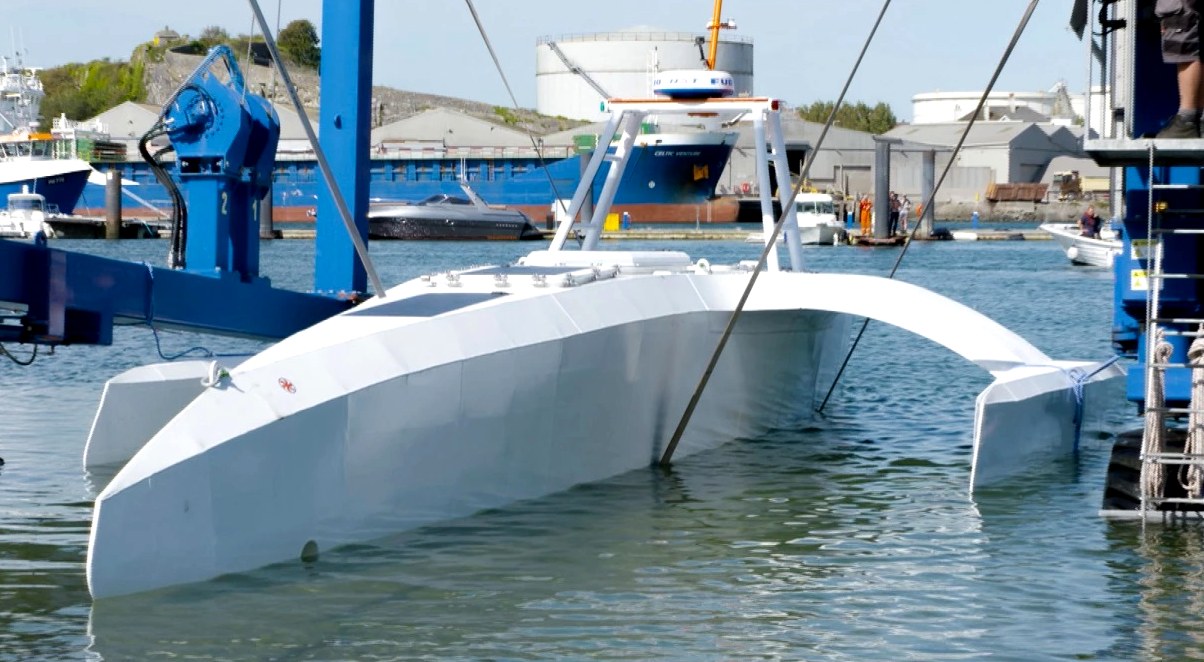
THE
FUTURE OF AUTONOMOUS SHIPPING
In many ways, IBM is testing the water for the future of autonomous shipping with the Mayflower.
Allied Market Research thinks the autonomous shipping market could be a $135
billion industry by 2030 and IBM is weighing up where and how its technology can be used.
Stanford-Clark believes that AI captains could be used to “look over the shoulder” of a human captain.
“That same technology that we’re putting in Mayflower will also be able to operate in a guardian angel sort of mode,” he said, adding that there’s a huge amount of interest in this technology from big shipping companies.
He believes there’s a “big opportunity” for container ships to become autonomous in the future, adding that it would help to keep supply chains open during pandemics.
Autonomous cars get all the attention but autonomous shipping is potentially even more useful.
“Everyone wants to see what we’re doing with Mayflower first but people are lining up to have these kind of conversations,” said Stanford-Clark.
By Sam Shead
BUSINESS LIVE 6 SEPTEMBER 2020 - PLYMOUTH
Work starts on pioneering £1m robot research ship. Top tech firms and manufacturers combine with researchers to create vessel which will sail from Plymouth to the USA in late 2020.
Cutting-edge tech firms and a leading marine research charity are building a £1million robot ship that will sail across the Atlantic to mark 400 years since the Pilgrim Fathers voyaged to America.
The hull of the Mayflower Autonomous Ship (MAS) is already under construction at a shipyard in Gdansk, Poland, and is due to arrive in Plymouth in early 2020 to be equipped with monitoring equipment, including acoustic, nutrient and temperature sensors, plus water and air sampler.
The 15m-long research vessel will be powered by renewable energy and unmanned – controlled remotely from a command centre in Plymouth.
It will be used to collect date and create a picture of ocean conditions and mammal behaviour right across the Atlantic.
The ambitious project is being funded by ProMare Foundation, a non-profit corporation and public charity established to promote marine research and exploration throughout the world.
It will be constructed by Plymouth submarine manufacturer M Subs, which has more than 20 years’ experience in mechanical engineering, composites, electrical, electronic and software design.
The firm has just signed a £2million deal to create a robot sub for the
Royal Navy and has produced unmanned submersibles for the US military.
The catamaran’s three data-collecting research pods will be coordinated by the University of Plymouth.
Other firms that have supported the MAS project include UTC Aerospace, Silicon Sensing Ltd, Plymouth Citybus, Rotec Hydraulics Ltd,
National
Instruments, and computer giant IBM.
Final outfitting and testing will take place in Plymouth and the boat is likely to be trialled around Plymouth Sound in mid-2020 ready for its pioneering voyage across the Atlantic to commemorate Mayflower 400.
That is [was to have] likely to take place in September 2020, 400 years after the original Mayflower sailed to America.
The project has been worked on since 2014, and the idea is for it to be used beyond its maiden voyage and become a prototype for autonomous marine research and exploration.
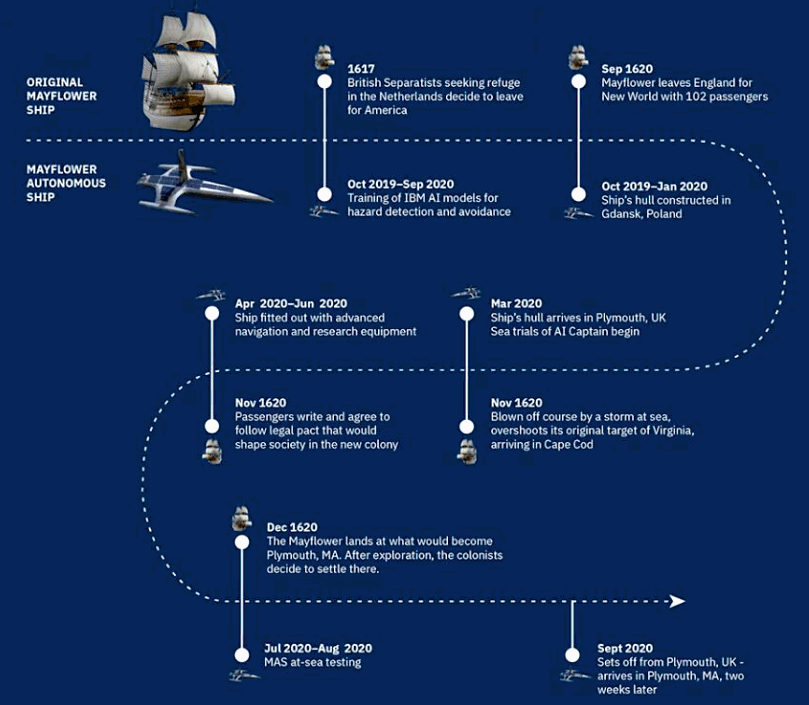
Brett Phaneuf, managing director of M Subs, is quoted as saying: “This ship will appropriately commemorate its predecessor’s voyage 400 years ago.
“It will also allow us to usher in a new phase of research with state-of-the-art technology. It enables us to once again put Plymouth on the map and celebrate the huge diversity of talent we have here, people who are interested in new beginnings and like to lean forward into new opportunities.
“Once it goes across the Atlantic it will go for a complete circumnavigation of the world. It will have marine AI on it with a command centre in Plymouth. The goal is for it not to be here too much, but to be out around the world.”
Mr Phaneuf said the MAS team had wanted the hull to be built in the UK but it was impossible to find a shipyard that could do it on time or on budget.
“It would have been three times as expensive to make in the UK,” he said. “Two yards were at 100% capacity and could not do it in time. The one that could was three times the cost of the
Polish
yard.”
Ayse Phaneuf, president of the ProMare Foundation, which will own MAS, said: “The original
Mayflower voyage was all about exploration into a new world, and this project is to a large extent the same.
“It takes autonomous marine vessels to a new level and opens up countless scientific possibilities. We have made considerable progress over the past three years, and it is exciting to now see our vision taking shape as we continue preparations for the crossing next September.”
Professor Kevin Jones, executive dean of science and engineering at the University of Plymouth, said: “This voyage has the potential to be a real game-changer and cements Plymouth’s reputation as a world-leading hub of marine science.
“It gives us the genuine capability to explore new and innovative research opportunities that have not previously been possible.
“It also raises the bar in terms of autonomous vessels, a world first that could set the standard for others in the field to follow.”
By
William
Telford
Email: william.telford@reachplc.com
Phone: 01752 293116
Mob: 07584 594052

LINKS
& CONTACTS
https://bluebird-electric.net/artificial_intelligence_autonomous_robotics/kickstarter_scout_solar_powered_autonomous_robot_boat_trans_atlantic_microtransat.htm
https://www.solar-nation.org/solar-boat-crossing-the-atlantic
http://www.solar-voyager.com/
https://www.cnbc.com/2020/09/10/testing-begins-on-autonomous-mayflower-ship-ahead-of-atlantic-voyage.html
https://www.irishtimes.com/news/science/aye-ai-captain-ibm-s-autonomous-ship-seeks-to-revolutionise-modern-transport-1.4397984
https://insideunmannedsystems.com/mayflower-autonomous-ship-on-shakedown-cruise-at-sea/
https://www.business-live.co.uk/manufacturing/work-starts-pioneering-1m-robot-16875962
https://www.marinelink.com/news/ai-solarpowered-autonomous-ship-mayflower-481779
https://www.crowdfunder.co.uk/mayflower-autonomous-ship
https://www.insidermedia.com/news/south-west/autonomous-ship-planned-for-mayflower-celebrations
https://nypost.com/2020/09/17/high-tech-ai-ship-launched-on-mayflowers-400th-anniversary/
https://www.businesstelegraph.co.uk/ai-ai-captain-how-the-mayflower-autonomous-ship-will-cross-the-atlantic/
https://www.robothusiast.com/mayflower-fully-autonomous-ship-with-ai-captain/
https://venturebeat.com/2020/03/04/ai-ai-captain-how-the-mayflower-autonomous-ship-will-cross-the-atlantic/
https://www.abc.net.au/radionational/programs/sundayextra/autonomous-shipping/12900456
https://www.fleetmon.com/maritime-news/2020/30917/worlds-first-fully-autonomous-ship-all-set-sea-tri/
https://www.thefirstnews.com/article/sleek-new-ai-mayflower-to-cross-atlantic-on-400th-anniversary-of-pilgrims-voyage-11488
https://www.punto-informatico.it/mayflower-autonomous-ship/
https://www.ship-technology.com/features/ai-in-shipping/
https://www.smithsonianmag.com/smart-news/mayflower-england-400-celebrations-exhibit-180975850/
https://mayflowereventnews.com/mayflower-autonomous-ship-project/
https://www.mayflower400uk.org/
https://www.mayflower400uk.org/news/2020/september/groundbreaking-mayflower-autonomous-ship-revealed-to-the-world/
http://www.promare.org/projects/
https://newsroom.ibm.com/then-and-now
The
current energy autonomous (solar powered) transatlantic record holder is the Tûranor
PlanetSolar, seen
below. Note, this boat was manned, not crewless. Nevertheless, with an
autopilot and collision avoidance sensors, in our view, she would easily
make it across the Atlantic
Ocean - from one waypoint to another in unmanned mode. But in 2012,
the technology was not so freely available. Today, several companies
offer full COLREGS
compliant navigation
systems.
